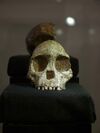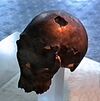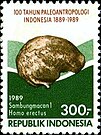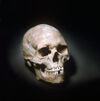Biology:List of human evolution fossils
| Part of a series on |
| Paleontology |
|---|
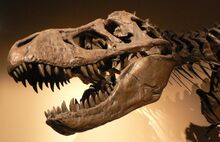 |
|
Paleontology Portal Category |
The following tables give an overview of notable finds of hominin fossils and remains relating to human evolution, beginning with the formation of the tribe Hominini (the divergence of the human and chimpanzee lineages) in the late Miocene, roughly 7 to 8 million years ago.
As there are thousands of fossils, mostly fragmentary, often consisting of single bones or isolated teeth with complete skulls and skeletons rare, this overview is not complete, but shows some of the most important findings. The fossils are arranged by approximate age as determined by radiometric dating and/or incremental dating and the species name represents current consensus; if there is no clear scientific consensus the other possible classifications are indicated.
The early fossils shown are not considered ancestors to Homo sapiens but are closely related to ancestors and are therefore important to the study of the lineage. After 1.5 million years ago (extinction of Paranthropus), all fossils shown are human (genus Homo). After 11,500 years ago (11.5 ka, beginning of the Holocene), all fossils shown are Homo sapiens (anatomically modern humans), illustrating recent divergence in the formation of modern human sub-populations.
Late Miocene (7.2–5.5 million years old)
The chimpanzee–human divergence likely took place during around 10 to 7 million years ago.[1] The list of fossils begins with Graecopithecus, dated some 7.2 million years ago, which may or may not still be ancestral to both the human and the chimpanzee lineage. For the earlier history of the human lineage, see Timeline of human evolution, Hominidae.
| Image | Name | Age (Ma) | Species | Year discovered |
Country | Discovered by | Now located at |
|---|---|---|---|---|---|---|---|
| El Graeco | 7.20[2] | Graecopithecus | 1944, 2017 | Greece, Bulgaria Site:Pyrgos Vassilissis, Azmaka |
Böhme (Tübingen), Spassov (BAS) | Met, Athens; Tübingen, Germany | |

|
TM 266 (Toumai) | 7.00–6.00[3] | Sahelanthropus tchadensis | 2001 | Chad Site:Djurab Desert |
Michel Brunet, Alain Beauvilain, Fanone Gongdibe, Mahamat Adoum and Ahounta Djimdoumalbaye | N'Djamena (Chad), BEAC |
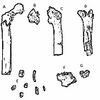
|
BAR 1000'00 | 6.1–5.7[4] | Orrorin tugenensis | 2000 | Kenya Site:Lukeino |
Martin Pickford, Kiptalam Cheboi, Dominique Gommery, Pierre Mein, Brigitte Senut | |

|
Trachilos footprints | 6.05[5] | Made by hominin or hominin-like primate | 2002 | Greece | Gerard D. Gierliński | |

|
ALA-VP 1/20[6] | 5.65±0.150 | Ardipithecus kadabba | 1997 | Ethiopia Site:Middle Awash |
Yohannes Haile-Selassie |
Pliocene (5.3–2.58 million years old)
| Image | Name | Age (Ma) | Species | Year discovered |
Country | Discovered by | Now located at |
|---|---|---|---|---|---|---|---|
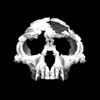
|
Ardi | 4.40[7] | Ardipithecus ramidus | 1994 | Ethiopia | Yohannes Haile-Selassie | |

|
Lothagam mandible (KNM-LT 329)[8] | 4.60±0.40[9] | Australopithecus anamensis or undetermined Hominidae | 1967 | Kenya | Arnold Lewis,[10] Bryan Patterson[11][12][13] | |
| KNM-TH 13150 | 4.70±0.55[14] | Australopithecus anamensis | 1984 | Kenya | Kiptalam Cheboi[11] | ||

|
KNM-KP 271 | 4.00[15] | Australopithecus anamensis | 1965 | Kanapoi, Kenya | Bryan Patterson[11] | |
| Laetoli Footprints | 3.70 | Bipedal hominin | 1976 | Tanzania | Mary Leakey | ||

|
LH 4 | 3.40±0.50 | Australopithecus afarensis | 1974 | Laetoli, Tanzania | Mary Leakey[16] | |
| KSD-VP-1/1 (Kadanuumuu) | 3.58 | Australopithecus afarensis | 2005 | Ethiopia | Yohannes Haile-Selassie | ||
| KT-12/H1 (Abel) | 3.50 | Australopithecus bahrelghazali | 1995 | Chad | Mamelbaye Tomalta and Michel Brunet | N'Djamena (Chad), BEAC | |
| KNM-WT 22944 G-J[17] | 3.50 | Australopithecus sp. | 1990 | Kenya | Multinational team | National Museums of Kenya | |

|
KNM-WT 40000 (Flat Faced Man)[18] | 3.50-3.20 | Kenyanthropus platyops | 1999 | Lake Turkana (West Lake Turkana), Kenya | Justus Erus and Meave Leakey[19] | |

|
BRT-VP-3/14 | 3.40±0.10 | Australopithecus deyiremeda | 2015 | Ethiopia | Yohannes Haile-Selassie[20] | |
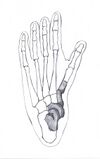
|
Stw 573 (Little foot) | 3.67 | Australopithecus prometheus(?) | 1994 | Sterkfontein, South Africa | Ronald J. Clarke | |

|
DIK-1 (Selam) | 3.30 | Australopithecus afarensis | 2000 | Ethiopia | Zeresenay Alemseged | |
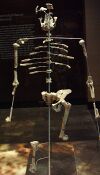
|
AL 288-1 (Lucy) | 3.20 | Australopithecus afarensis | 1974 | Ethiopia | Tom Gray, Donald Johanson, Yves Coppens and Maurice Taieb | National Museum of Ethiopia |
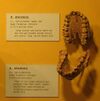
|
AL 200-1 | 3.10±0.10 | Australopithecus afarensis | 1975 | Afar Region, Ethiopia | Donald Johanson Yves Coppens and Maurice Taieb | |
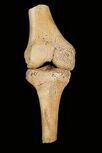
|
AL 129-1 | 3.10±0.10 | Australopithecus afarensis | 1973 | Afar Region, Ethiopia | Donald Johanson | |

|
AL 444-2[21] | 3.00 | Australopithecus afarensis | 1992 | Afar Region, Ethiopia | Yoel Rak | |

|
LD 350-1[22] | 2.775±0.025[23] | Homo(?) | 2013 | Ethiopia | Chalachew Seyoum | |
| Taung Child 1 | 3.03–2.61 | Australopithecus africanus | 1924 | Buxton-Norlim Limeworks, South Africa | Raymond Dart | University of the Witwatersrand |
Pleistocene
Lower Paleolithic: 2.58–0.3 million years old
| Name | Age (Ma) | Species | Date discovered |
Country | Discovered by | Now located at | |
|---|---|---|---|---|---|---|---|

|
KNM-WT 17000 (The Black Skull) |
2.50 | Paranthropus aethiopicus | 1985 | Kenya | Alan Walker | |
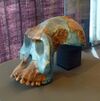
|
BOU-VP-12/130[24] | 2.50 | Australopithecus garhi | 1997 | Ethiopia | Yohannes Haile-Selassie | |
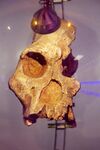
|
STS 71[25] | 2.61–2.07 | Australopithecus africanus | 1947 | Sterkfontein, South Africa | Robert Broom and John T. Robinson | Ditsong National Museum of Natural History |

|
STS 52 | 2.61–2.07 | Australopithecus africanus | 1947 | Sterkfontein, South Africa | Robert Broom | Ditsong National Museum of Natural History |

|
UR 501 (Uraha jawbone) | 2.40±0.10 | Homo rudolfensis[26] | 1991 | Malawi | Tyson Msiska, Timothy Bromage, Friedemann Schrenk | |

|
STS 5 (Mrs. Ples) (STS 14)[27] |
2.07[28] | Australopithecus africanus | 1947 | Sterkfontein, South Africa | Robert Broom | Ditsong National Museum of Natural History |
| DNH 134 (Simon)[29] | 2.04[29] | Homo erectus | 2015 | Drimolen Main Quarry, South Africa | Andy Herries' team (excavated by Richard Curtis, Andy Herries, Angeline Leece; reconstructed by Jesse Martin) | University of the Witwatersrand | |
| DNH 155[30] | 2.04–1.95 | Paranthropus robustus | 2018 | Drimolen Main Quarry, South Africa | Andy Herries and Stephanie Baker's team (first found by Samantha Good and excavated by Samantha Good, Angeline Leece, Stephanie Baker and Andy Herries; reconstructed by Jesse Martin) | University of the Witwatersrand | |
| DNH 152[29](Khethi) | 2.04–1.95[29] | Paranthropus robustus | 2018 | Drimolen Main Quarry, South Africa | Andy Herries and Stephanie Baker's team (first part found by Khethi Nkosi. later parts by Amber Jaeger, Eunice Lalunio; reconstructed by Jesse Martin & Angeline Leece) | University of the Witwatersrand | |

|
DNH 7 (Eurydice)[31] |
2.04–1.95[29] | Paranthropus robustus | 1994 | Drimolen, Drimolen Main Quarry, South Africa | R. Smith and André Keyser | University of the Witwatersrand |
| KNM-ER 64060 | 2.03 | Homo habilis | 2012 | Ileret, Kenya | |||
| KNM-ER 64061 | 2.02 | Homo erectus | 2012-2013 | Ileret, Kenya | |||

|
TM 1517[32] | 2.0 | Paranthropus robustus | 1938 | South Africa | Gert Terblanche | Ditsong National Museum of Natural History |

|
MH1 (Karabo)[33][34] | 1.98[35] | Australopithecus sediba | 2008 | Malapa, South Africa | Matthew Berger and Lee Rogers Berger | University of the Witwatersrand |

|
KNM-ER 1813 | 1.90 | Homo habilis | 1973 | Kenya | Kamoya Kimeu | |

|
KNM-ER 1470 | 1.90 | Homo rudolfensis | 1972 | Kenya | Bernard Ngeneo[36] | |

|
SK 48 | 2.25–1.80 | Paranthropus robustus | 1948 | Swartkrans, South Africa | Robert Broom | Ditsong National Museum of Natural History |
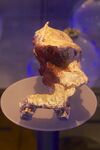
|
SK 46[37] | 2.25–1.80 | Paranthropus robustus | 1949 | Swartkrans, South Africa | Robert Broom | Ditsong National Museum of Natural History |

|
SK 847[38] | 2.25–1.80 | Homo habilis | 1949 | Swartkrans, South Africa | Ditsong National Museum of Natural History | |

|
OH 24 (Twiggy)[39] |
1.80 | Homo habilis | 1968 | Tanzania | Peter Nzube | |
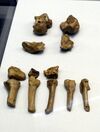
|
OH 8[40] | 1.80 | Homo habilis | 1960 | Olduvai, Tanzania | ||

|
D2700 (Dmanisi Skull 3) | 1.81±0.40[41] | Homo erectus | 2001 | Dmanisi, Georgia | David Lordkipanidze and Abesalom Vekua | |

|
D3444 (Dmanisi Skull 4) | 1.81±0.40 | Homo erectus | 2003 | Dmanisi, Georgia | David Lordkipanidze | |

|
D4500 (Dmanisi Skull 5) | 1.81±0.40 | Homo erectus | 2005 (published in 2013) | Dmanisi, Georgia | David Lordkipanidze | |
| KNM-ER 62000–62003[42] | 1.84±0.60 | Homo rudolfensis | 2012 | Koobi Fora, Kenya | Meave Leakey's team | ||
| KNM-ER 64062 | 1.84±0.02 | Homo erectus | 2013 | Ileret, Kenya | |||
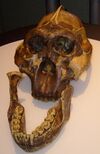
|
OH 5 (Zinj or nutcracker man) |
1.75 | Paranthropus boisei | 1959 | Tanzania | Mary Leakey | |

|
OH 7 | 1.75 | Homo habilis | 1960 | Tanzania | Jonathan Leakey | |
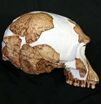
|
StW 53 | 1.8–1.6[28] | variously A. africanus, H. habilis, H. gautengensis | 1976 | Sterkfontein, South Africa | A. R. Hughes | University of the Witwatersrand |

|
KNM-ER 1805 | 1.74 | Homo habilis | 1973/4 | Kenya | Paul Abell | |

|
Yuanmou Man | 1.70 or 0.60–0.50 (disputed)[43] |
Homo erectus | 1965 | China | Fang Qian | |

|
KNM-ER 406 | 1.70 | Paranthropus boisei | 1969 | Kenya | Richard Leakey | |

|
KNM-ER 732[44] | 1.70 | Paranthropus boisei | 1970 | Kenya | Richard Leakey | |

|
KNM-ER 23000[45] | 1.70 | Paranthropus boisei | 1990 | Koobi Fora, Kenya | Benson Kyongo | |

|
KNM-WT 17400[46][47] | 1.70 | Paranthropus boisei | Not known[48] | Lake Turkana (West Lake Turkana) Kenya | unknown[48] | National Museums of Kenya, Nairobi (Kenia) |
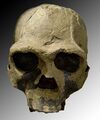
|
KNM-ER 3733 | 1.63±0.15[49] | Homo ergaster (a.k.a. African Homo erectus) | 1975 | Kenya | ||
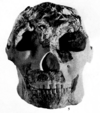
|
Lantian Man | 1.62±0.03 | Homo erectus | 1963 | Lantian County, China | Woo Ju-Kang | |

|
KNM-WT 15000 (Turkana Boy) |
1.60 | Homo ergaster (a.k.a. African Homo erectus) | 1984 | Lake Turkana (West Lake Turkana), Kenya | Kamoya Kimeu | Kenya National Museum |
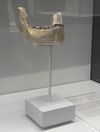
|
Peninj Mandible | 1.50 | Paranthropus boisei | 1964 | Tanzania | Richard Leakey | |

|
Ileret Footprints | 1.50 | Homo erectus | 2007-2014 | Ileret, Kenya | ||

|
KNM-ER 992 | 1.50 | Homo ergaster (a.k.a. African Homo erectus) | 1971 | Kenya | Richard Leakey | |
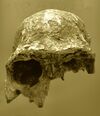
|
KNM-ER 3883 | 1.57±0.08 | Homo erectus | 1976 | Kenya | Richard Leakey | |

|
Mojokerto 1 (Mojokerto child) |
1.43±0.10 | Homo erectus | 1936 | Indonesia | Andojo, G.H.R. von Koenigswald | |
| BL02-J54-100[50] | 1.40 | Similar to H. heidelbergensis | Unknown | Spain | Unknown | ||
| KGA 10-525[51][52] | 1.40 | Paranthropus boisei | 1993 | Konso-Gardula, Ethiopia | A. Amzaye | ||

|
OH 9 (Chellean Man)[53] |
1.40 | Homo erectus | 1960 | Olduvai, Tanzania | Louis Leakey | |
| Sima del Elephante maxilla[54] | 1.40 | Homo erectus? | 2022 | Spain | |||

|
ATE9-1[55] | 1.20 | Homo sp.Homo erectus?[54] | 2008 | Spain | Eudald Carbonell | Museo de la Evolución Humana, Burgos (Spain) |

|
Kocabaş | 1.10[56] | Homo erectus[57] | 2002 | Turkey | M. Cihat Alçiçek | |

|
Daka | 1.00 | Homo erectus | 1997 | Ethiopia | Henry Gilbert | |

|
Sangiran 4 | 1.00 | Homo erectus | 1939 | Indonesia | G.H.R. von Koenigswald | |

|
Sangiran 2 | 1.15±0.45 | Homo erectus | 1937 | Indonesia | G.H.R. von Koenigswald | |

|
Madam Buya[58] | 1.00 | Homo erectus | 1997 | Eritrea | Ernesto Abbate | National Museum of Eritrea |
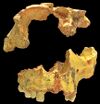
|
ATD6-15 and ATD6-69
(Niño de la Gran Dolina 342) |
0.900[59] | Homo antecessor or Homo erectus |
1994 | Spain | Bermúdez & Arsuaga | Museo de la Evolución Humana, Burgos (Spain) |
| Trinil 2 Pithecanthropus-1 or Java Man[60] |
0.850±0.150 | Homo erectus | 1891 | Indonesia | Eugène Dubois | Naturalis Biodiversity Center, Leiden | |

|
Ternifine 2-3 now Tighennif[61] | 0.70 | Homo erectus | 1954 | Algeria | C. Arambourg & B. Hoffstetter | |

|
Sangiran 17[62] | 0.70 | Homo erectus | 1969 | Indonesia | S. Sartono | |

|
Peking Man | 0.73±0.50[63] | Homo erectus | 1921 | China | Davidson Black | Lost/stolen |
| Nanjing Man | 0.60±0.02 | Homo erectus | 1993 | China | Liu Luhong | ||

|
Bodo[64] | 0.600 | Homo heidelbergensis or Homo erectus |
1976 | Ethiopia | A. Asfaw | |
| Benjamina[65][66] | 0.53 | Homo neanderthalensis[67] | 2001-2001 | Spain | Ana Gracia Téllez | ||

|
Mauer 1 (Heidelberg Man) |
0.50 | Homo heidelbergensis | 1907 | Germany | Daniel Hartmann | Heidelberg University |

|
Saldanha man[68] | 0.50 | Homo rhodesiensis | 1953 | South Africa | ||
| Boxgrove Man | 0.50[69] | Homo heidelbergensis | 1994 | UK | Natural History Museum | ||
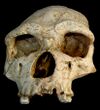
|
Arago 21 (Tautavel Man) |
0.45 | Homo erectus | 1971 | France | Henry de Lumley | |
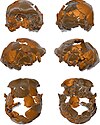
|
Ceprano Man[70][71] | 0.450±0.050 | Homo cepranensis /Homo heidelbergensis |
1994 | Ceprano, Italy | Italo Biddittu | Servizio di antropologia, Soprintendenza ai beni culturali, Regione Lazio, Italy |

|
Agamenón[72] | 0.43 | Homo neanderthalensis[67] | 1997 | Spain | Paleontological teams | Museo de la Evolución Humana, Burgos (Spain) |

|
Miguelón | 0.40 | Homo neanderthalensis[67] | 1992 | Spain | Bermúdez, Arsuaga & Carbonell | Museo de la Evolución Humana, Burgos (Spain) |

|
Aroeira 3 | 0.40 | Homo heidelbergensis | 2014 | Portugal | João Zilhão (de) | Museu Nacional de Arqueologia, Lisbon |

|
Salé cranium[73][74][75] | 0.40-0.20 | Homo sapiens?[76] | 1971 | Morocco | Quarry worker | |

|
Swanscombe Man[77] | 0.40 | Homo neanderthalensis | 1935, 1936, 1955 | UK | Alvan T Marston, John J Wymer and Adrian Gibson | Natural History Museum |

|
Ndutu[78][79] | 0.45±.04 | Homo neanderthalensis affinities | 1973 | Tanzania | A.A. Mturi | |
| Hexian Man[80][81] | 0.412±0.025[82] | Homo erectus | 1980-1981[83] | Hexian, China | |||

|
Gawis cranium | 0.350±0.150 | Homo erectus/Homo sapiens | 2006 | Ethiopia | Asahmed Humet | |
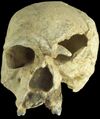
|
Steinheim Skull | 0.35 | Homo heidelbergensis | 1933 | Germany | ||
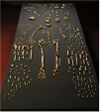
|
Dinaledi Chamber hominins | 0.325±0.090[84] | Homo naledi | 2013 | South Africa | Rick Hunter and Steven Tucker | University of the Witwatersrand (South Africa) |

|
Homo heilbergensis | 1949 | France | Musée de l’Homme | |||

|
BH-1 | 0.4[85] | Homo heidelbergensis | Mala Balanica, Serbia |
Middle Paleolithic: 300,000–50,000 years old
| Name | Age (ka) | Species | Year discovered |
Country | Discovered by | Now located at | |
|---|---|---|---|---|---|---|---|

|
Dragon Man | 309–138 | Homo longi | 1933 | China | Hebei GEO University | |

|
Broken Hill 1 (Kabwe 1, Rhodesian Man) |
299±25[86] | Homo rhodesiensis (Homo heidelbergensis) | 1921 | Zambia | Tom Zwiglaar | |

|
Jebel Irhoud 1–5 | 315±32[87] | Homo sapiens | 2017 | Morocco | INSAP | |

|
Samu[88] | 275±25 | Homo heidelbergensis | 1964 | Hungary | László Vértes | |

|
Dali Man[89] | 260±20[90] | Homo daliensis | 1978 | China | Shuntang Liu | |

|
Jinniushan | 260-200 ka[91] | Homo longiHomo daliensis | 1984 | China [92] | Paleolithic Archeology Student Excavation Team[92] | |

|
Florisbad Skull | 259±35 | early Homo sapiens or Homo heidelbergensis or Homo helmei |
1932 | South Africa | T. F. Dreyer, G. Venter | |

|
Galilee Man | 250±50 | Homo heidelbergensis | 1925 | Israel | Francis Turville-Petre | |

|
Coupe-Gorge[93] | 250 | Homo heidelbergensis | 1949 | France | Raoul Cammas | |

|
Montmaurin-La Niche mandible[94] | 250 | Homo heidelbergensis | 1949 | France | Raoul Cammas | Musée de l’Homme |
| Saccopastore 1 | 250[95] | Homo neanderthalensis | 1929 | Grotta Guattari / Italy | Mario Grazioli | ||
| Saccopastore 2[96] | 250 | Homo neanderthalensis | 1935 | Grotta Guattari / Italy | Henry Breuil and Alberto Carlo Blanc | ||
| Narmada Cranium | 236-46 | Homo erectus or Homo sapiens | Narmada River | ||||
| Bontnewydd Palaeolithic site, Denbighshire, Wales | 230 | Homo neanderthalensis | 1981 | Wales, UK | |||
| Apidima 1 (LAO 1/S1) |
210[97] | Homo sapiens | 1978 | Apidima Cave / Greece | Theodore Pitsios[98] | ||

|
Petralona 1 | 200±40[99] | Homo heidelbergensis (uncertain) | 1960 | Greece | ||
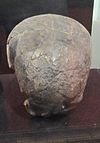
|
Omo remains | 233±22[100] or 195±5[101] | Homo sapiens | 1967 | Ethiopia | Richard Leakey | |
| Laterite Baby | 190(?)[102] | H. erectus or H. sapiens |
2001 | Tamil Nadu, India | P Rajendran | ||
| Misliya-1 | 187±13[103] | Homo sapiens | 2002 | Israel | Israel Hershkovitz | ||
| Apidima 2 (LAO 1/S2) |
170[97] | Homo neanderthalensis | 1978 | Apidima Cave / Greece | Theodore Pitsios[98] | ||

|
Penghu 1 | 160±30 or 40±30[104] | Homo tsaichangensis[105][106][107] | 2008, c c. 2008
|
Taiwan | National Museum of Natural Science | |

|
Herto remains[108] | 160 | Homo sapiens | 1997 | Ethiopia | Tim White | |

|
Xiahe mandible | Denisovan | 1980 | China | |||
| Altamura Man | Homo neanderthalensis | 1993 | Italy | in situ | |||

|
Nesher Ramla Homo | 140±120 | Nesher Ramla Homo or Homo neanderthalensis |
2021 | Israel | Israel Hershkovitz | |
| Maba Man | 140±120 | early modern human,
Homo neanderthalensis or |
1958 | Shaogun, China | Institute of Vertebrate Paleontology and Paleoanthropology | ||

|
LH 18 | 120±30 | Homo sapiens | 1976 | Ngaloba beds at Laetoli, Tanzania | Mary Leakey[109] | |
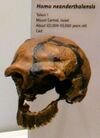
|
Tabun C1[110] | 120 | Homo neanderthalensis | 1967 | Israel | Arthur Jelinek | |
| Sarstedt (Sst) I-III[111] | 115-58 ka | Homo neanderthalensis? | 1997-1999 | Germany | Frangenberg brothers | ||
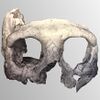
|
Krapina 3[112] | 113.5±13.5[113] | Homo neanderthalensis | 1899 | Croatia | Dragutin Gorjanović-Kramberger | |

|
Ngandong 7 | 112[114] | Homo erectus | 1931 | Indonesia | C. ter Haar and G. H. R. von Koenigswald | |
| Denisova 8 | Denisovan | 2010 | Russia | ||||

|
Qafzeh 6[115] | 95±5[113] | Homo sapiens | 1930 | Israel | R. Neuville, M. Stekelis | |

|
Qafzeh 9 | 100–90[113] | Homo sapiens[116][117] | 1933 | Israel | B. Vandermeersch | |
| Scladina | 103±23[113] | Homo neanderthalensis | 1993 | Belgium | |||

|
Skhul 5 | 100±20 | Homo sapiens | 1933 | Israel | T. McCown and H. Moivus Jr. | |
| Skhul 9 | 100±20 | Homo sapiens | Israel | ||||
| Klasies River Caves[118] | 100±25 | Homo sapiens | 1960 | South Africa | Ray Inskeep, Robin Singer, John Wymer, Hilary Deacon | ||
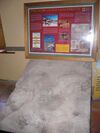
|
Eve's footprints | 117 | Homo sapiens | 1995 | South Africa | David Roberts & Lee R. Berger | |

|
Liujiang man | 113.5±45.5 | Homo sapiens | 1958 | China | ||

|
Denny[119][120][121] | 90 | Hybrid – (Homo neanderthalensis/Homo sapiens denisova) | 2012 | Denisova Cave / Siberia / Russia | Viviane Slon & Svante Pääbo | Max Planck Institute for Evolutionary Anthropology (Leipzig, Germany) |
| Obi-Rakhmat 1[122] | 75[113] | Homo neanderthalensis | 2003 | Uzbekistan | |||

|
Teshik-Tash Skull[123] | 70 | Homo neanderthalensis | 1938 | Uzbekistan | A. Okladnikov | |

|
La Ferrassie 1 | 70 | Homo neanderthalensis | 1909 | France | R. Capitan and D. Peyrony | |
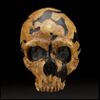
|
Shanidar 1 | 70±10 | Homo neanderthalensis | 1961 | Iraq | Ralph Solecki | |
| Sambungmacan (Sm) 1-4 | 70- 40[124] | Homo erectus | 1973-2001[124] | Indonesia | Construction and fossil collectors[124] | ||

|
La Quina 5[125] | 65 | Homo neanderthalensis | France | |||
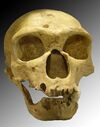
|
La Chapelle-aux-Saints 1 | 60 | Homo neanderthalensis | 1908 | France | A. and J. Bouyssonie and L. Bardon | |

|
Kebara 2 (Moshe)[126] | 60 | Homo neanderthalensis | 1983 | Israel | Lynne Schepartz | |
| Amud 7[127] | 55±5 | Homo neanderthalensis | Israel | ||||

|
LB 1 (Hobbit) | 55±5 | Homo floresiensis | 2003 | Liang Bua, Indonesia | Peter Brown | |
| Manot 1 | 55 | Homo sapiens | 2008 | Israel | [128] | ||

|
52.5±7.5[113] | Homo neanderthalensis | France | ||||
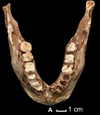
|
Tam Pa Ling Cave[129] | 54.5±8.5[129][130] | Homo sapiens | 2009 | Laos |
Upper Paleolithic: 50,000–11,500 years old
| Name | Age (ka) | Species | Date discovered |
Country | Discovered by | Now located at | |
|---|---|---|---|---|---|---|---|

|
Homo luzonensis | 50±10 | Homo luzonensis | 2007 | Philippines | Florent Détroit & Armand Mijares | |
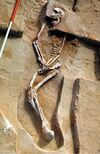
|
Mungo Man | 50±10 | Homo sapiens | 1974 | Australia | ||

|
Mt. Circeo 1[131] | 50±10 | Homo neanderthalensis | 1939 | Italy | Prof. Blanc | |
| SID-00B | 49.2±2.5[132] | Homo neanderthalensis | 1994 | Sidrón Cave, Spain | |||
| Simanya Neanderthals[133] | 49-42 | Homo neanderthalensis | 1978-1979, 2022 | Simanya cave | Miguel Aznar | Archaeology Museum of Catalonia | |
| Ust'-Ishim man | 45 | Homo sapiens | 2008 | Russia | Nikolai Peristov | ||
| Kents Cavern 4 maxilla | 43.5±2.5 | Homo sapiens | 1927 | UK | |||
| Zlatý kůň woman | 43 | Homo sapiens | 1950 | Czech Republic | |||
| Tianyuan man | 40.5±1.5 | Homo sapiens | 2007 | China | |||

|
Amud 1[134] | 41[135] | Homo neanderthalensis | 1961 | Israel | Hisashi Suzuki | |

|
Neanderthal 1[136] | 40 | Homo neanderthalensis | 1856 | Germany | Johann Carl Fuhlrott | |

|
Denisova hominin (X-Woman) | 40 | Homo sp. Altai | 2008 | Russia | Johannes Krause, et al. | |

|
hominin toe bone | 40 | Homo sp. Altai (possible Neanderthal–Denisovan hybrid) | 2010 | Russia | ||
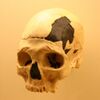
|
Oase 1 | 42–37[137] | Homo sapiens (EEMH x Neanderthal hybrid) | 2002 | Romania | ||
| Kostenki-14 (Markina Gora) | 40–37[138] | Homo sapiens (EEMH) | 1954 | Russia | |||
| SID-20[139] | 37.30±0.83[132] | Homo neanderthalensis | 1994 | Sidrón Cave, Spain | |||
| Balangoda Man | 37 | Homo sapiens | 2012 | Sri Lanka | |||

|
Hofmeyr Skull | 36 | Homo sapiens | 1952 | South Africa | ||
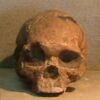
|
Wadjak 1[140] | 33±4.5[141] | Homo sapiens (proto-Australoid[142]) | 1888 | Indonesia | ||

|
Red Lady of Paviland | 33 | Homo sapiens | 1823 | Wales, UK | William Buckland | |
| Yamashita-Cho Man | 32 | Homo sapiens | 1962 | Japan | |||

|
Engis 2 | 40±10[113][143] | Homo neanderthalensis | 1829 | Belgium | Philippe-Charles Schmerling | |

|
Gibraltar 1 | 40±10[113] | Homo neanderthalensis | 1848 | Gibraltar | Captain Edmund Flint | |

|
Le Moustier | 40±10 | Homo neanderthalensis | 1909 | France | ||

|
Denisovan tooth | 40±10 | Homo sp. Altai | 2000 | Russia | ||
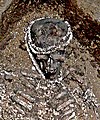
|
Sungir I | 30.25±0.25 | Homo Sapiens | Russia | |||
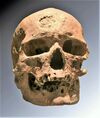
|
Cro-Magnon 1 | 30 | Homo sapiens (EEMH) | 1868 | France | Louis Lartet | |

|
WLH-50 | 29±5 | Homo sapiens | 1982 | Australia | ||

|
Predmost 3[144] | 26 | Homo sapiens | 1894 | Czech Republic | Karel Jaroslav Maška | |
| Lapedo Child | 24.5 | Homo neanderthalensis or Homo sapiens |
1998 | Portugal | João Zilhão | ||
| Mid-Upper Paleolithoic human humerus from Eel Point, Caldey Island, Wales, UK[145] | 24 | Homo sapiens | 1997 | Wales, UK | |||

|
MA-1 (Mal'ta boy) | 24 | Homo sapiens (ANE) | 1920s | Russia | ||

|
Abri Pataud Woman | 20.6 | Homo sapiens | France | |||
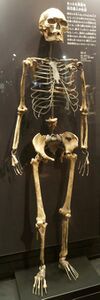 [146] [146]
|
Minatogawa 1 | 17±1 | Homo sapiens | 1970 | Japan | Anthropology Museum, Tokyo University | |
| Tandou[147][148] | 17 | Homo sapiens | 1967 | Australia | Duncan Merrilees | ||

|
Gough's Cave[149][150] | 14.7 | Homo sapiens | 2010 | UK | ||

|
Iwo Eleru skull | 13[151] | Homo sapiens | 1965 | Nigeria | ||
| "Kotias"[152] | 13 | Homo sapiens (CHG) | Kotias Klde cave, Georgia | ||||
| Arlington Springs Man | 13[153] | Homo sapiens | 1959 | United States | Phil Orr | ||

|
Chancelade find | 14.5±2.5[154] | Homo sapiens | 1888 | France | ||

|
Villabruna 1 | 14 | Homo sapiens (WHG) | 1988 | Italy | ||
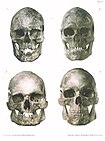
|
Bonn-Oberkassel double burial[155] | 14-13[155] | Homo sapiens | 1914[156] | Germany | ||
| Bichon man | 13.7 | Homo sapiens (WHG) | 1956 | Switzerland | |||
| Red Deer Cave | 13±1.5 | Homo sapiens | 1979 | China | Darren Curnoe? | ||
| PES-1[157] | 31–29 | Uncertain, possibly Homo sapiens | Serbia | ||||
| PES-2 | 38.9–92 | Uncertain, possibly Homo neanderthalensis | Serbia |
Holocene (11,500–5,000 years old)
| Name | Age (ka) | Culture / association |
Year discovered |
Country | |
|---|---|---|---|---|---|

|
Luzia | 11.5[158] | Paleo-Indian | 1975 | Brazil |
| [159] | Cerro Sota 2[160] | 11 | 1936 | Chile | |
| "Satsurblia" | 10 | Caucasian Epipaleolithic (CHG)[152] | Georgia | ||

|
Yaho skull[161] | 10? | 1961 | Chad | |

|
Kow Swamp 1 | 13–9 | 1968 | Australia | |
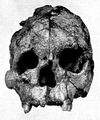
|
Talgai Skull[162] | 10±1 | 1886 | Australia | |

|
La Brea Woman | 10 (8000 BC) | Paleo-Indian | 1914 | United States |
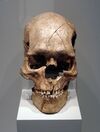
|
Combe Capelle | 9.6 (7600 BC)[163] | European Mesolithic | 1909 | France |
| Asselar man | Between 9500 BP and 7000 BP, with caution, 6390 BP[164] | Neolithic | 1927 | Mali | |

|
Cheddar Man | 9 (7000 BC) | British Mesolithic | 1903 | UK |
| Kennewick Man | 9 (7000 BC) | Archaic period (North America) | 1996 | United States | |
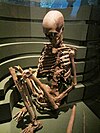
|
Barum Woman | 8.8 (6800 BC) | European Mesolithic | 1939 | Sweden |

|
Tepexpan man | 8±3 | Paleo-Indian | 1947 | Mexico |

|
Loschbour man[165] | 8 (6000 BC) | European Mesolithic (WHG) | 1935 | Luxembourg |

|
Minnesota Woman | 7.9±0.1 (5900 BC) | Paleo-Indian | 1931 | Minnesota, United States |
| Lothagam 4b (Lo 4b)[166] | 7.5±1.5[167] | 1965–1975 | Kenya | ||

|
Bessé’[168] | 7.3–7.2 | Toalean | 2015 | Sulawesi, Indonesia |

|
Ötzi | 5.3 (3230 BC) | European Neolithic | 1991 | Ötztal Alps, Italy |
Abbreviations used in fossil catalog name
- AL – Afar Locality, Ethiopia
- ARA-VP – Aramis Vertebrate Paleontology, Ethiopia
- BAR – (Lukeino, Tugen Hills) Baringo District, Kenya
- BOU-VP – Bouri Vertebrate Paleontology, Ethiopia
- D – Dmanisi, Georgia
- ER – East (Lake) Rudolf, Kenya
- KGA – Konso-Gardula, Ethiopia
- KNM – Kenya National Museum
- KP – Kanapoi, Kenya
- LB – Liang Bua, Indonesia
- LH – Laetoli Hominid 4, Tanzania
- MH – Malapa Hominin, South Africa
- NG – Ngandong, Indonesia
- OH – Olduvai Hominid, Tanzania
- SK – Swartkrans, South Africa
- Sts, Stw – Sterkfontein, South Africa
- TM – Transvaal Museum, South Africa
- TM – Toros-Menalla, Chad
- WT – West (Lake) Turkana, Kenya
See also
- Human timeline
- List of archaeological sites by continent and age
- List of first human settlements
- List of fossil primates
- List of fossil sites
- List of mummies
- List of transitional fossils
- Timeline of human evolution
- Timeline of prehistory
Further reading
- Gibbons, Ann. The First Human: The Race to Discover our Earliest Ancestor. Anchor Books (2007). ISBN:978-1-4000-7696-3
- Hartwig, Walter Carl (2004). Hartwig, Walter. ed. The Primate Fossil Record. Cambridge University Press. ISBN 978-0-521-08141-2. Bibcode: 2002prfr.book.....H. https://books.google.com/books?id=Ezm1OA_s6isC&q=hartwig+primate..
- Johanson, Donald & Wong, Kate. Lucy's Legacy: The Quest for Human Origins. Three Rivers Press (2009). ISBN:978-0-307-39640-2
- Jones, Steve, ed (1994). The Cambridge Encyclopedia of Human evolution. Cambridge University Press. ISBN 978-0-521-46786-5. (Note: this book contains very useful, information dense chapters on primate evolution in general, and human evolution in particular, including fossil history).
- Leakey, Richard & Lewin, Roger. Origins Reconsidered: In Search of What Makes us Human. Little, Brown and Company (1992). ISBN:0-316-90298-5
- Lewin, Roger. Bones of Contention: Controversies in the Search for Human Origins. Penguin Books (1987). ISBN:0-14-022638-9
- Morwood, Mike & van Oosterzee, Penny. A New Human: The Startling Discovery and Strange Story of the 'Hobbits' of Flores, Indonesia. Smithsonian Books (2007). ISBN:978-0-06-089908-0
- Oppenheimer, Stephen. Out of Eden: The Peopling of the World. Constable (2003). ISBN:1-84119-697-5
- Roberts, Alice. The Incredible Human Journey: The Story of how we Colonised the Planet. Bloomsbury (2009). ISBN:978-0-7475-9839-8
- Shreeve, James. The Neanderthal Enigma: Solving the Mystery of Modern Human Origins. Viking (1996). ISBN:0-670-86638-5
- Stringer, Chris. The Origin of Our Species. Allen Lane (2011). ISBN:978-1-84614-140-9
- Stringer, Chris & Andrews, Peter. The Complete World of Human Evolution. Thames & Hudson (2005). ISBN:0-500-05132-1
- Stringer, Chris & McKie, Robin. African Exodus: The Origins of Modern Humanity. Jonathan Cape (1996). ISBN:0-224-03771-4
- van Oosterzee, Penny. The Story of Peking Man. Allen & Unwin (1999). ISBN:1-86508-632-0
- Walker, Allan & Shipman, Pat. The Wisdom of the Bones: In Search of Human Origins. Weidenfeld & Nicolson (1996). ISBN:0-297-81670-5
- Wade, Nicholas. Before the Dawn: Recovering the Lost History of our Ancestors. Penguin Press (2006). ISBN:978-0-7156-3658-9
- Weiss, M.L.; Mann, A.E. (1985). 'Human Biology and Behaviour: An anthropological perspective (4th ed.). Boston: Little Brown. ISBN 978-0-673-39013-4. (Note: this book contains very accessible descriptions of human and non-human primates, their evolution, and fossil history).
- Wells, Spencer (2004). The Journey of Man : A Genetic Odyssey. New York: Random House Trade Paperbacks. ISBN 978-0-8129-7146-0.
References
- ↑ "In effect, there is now no a priori reason to presume that human-chimpanzee split time are especially recent, and the fossil evidence is now fully compatible with older chimpanzee–human divergence dates [7 to 10 Ma]" "Ardipithecus ramidus and the paleobiology of early hominids". Science 326 (5949): 75–86. October 2009. doi:10.1126/science.1175802. PMID 19810190. Bibcode: 2009Sci...326...75W.
- ↑ Fuss, Jochen; Spassov, Nikolai; Begun, David R.; Böhme, Madelaine (2017-05-22). "Potential hominin affinities of Graecopithecus from the Late Miocene of Europe". PLOS ONE 12 (5): e0177127. doi:10.1371/journal.pone.0177127. ISSN 1932-6203. PMID 28531170. Bibcode: 2017PLoSO..1277127F.
- ↑ Brunet, Michel; Guy, Franck; Pilbeam, David; Mackaye, Hassane Taisso; Likius, Andossa; Ahounta, Djimdoumalbaye; Beauvilain, Alain; Blondel, Cécile et al. (2002). "A new hominid from the Upper Miocene of Chad, Central Africa". Nature 418 (6894): 145–51. doi:10.1038/nature00879. PMID 12110880. Bibcode: 2002Natur.418..145B. http://doc.rero.ch/record/13388/files/PAL_E190.pdf.
- ↑ "Bar 10200'". Smithsonian National Museum of Natural History. 2010-01-23. http://humanorigins.si.edu/evidence/human-fossils/fossils/bar-100200.
- ↑ Kirscher, Uwe; El Atfy, Haytham; Gärtner, Andreas; Dallanave, Edoardo; Munz, Philipp; Niedźwiedzki, Grzegorz; Athanassiou, Athanassios; Fassoulas, Charalampos et al. (2021-10-11). "Age constraints for the Trachilos footprints from Crete". Scientific Reports 11 (1): 19427. doi:10.1038/s41598-021-98618-0. ISSN 2045-2322. PMID 34635686. Bibcode: 2021NatSR..1119427K.
- ↑ "Ardipithecus kadabba". efossils. http://www.efossils.org/species/ardipithecus-kadabba.
- ↑ Amos, Jonathan (2009-10-01). "Fossil finds extend human story". BBC News. http://news.bbc.co.uk/1/hi/8285180.stm.
- ↑ "What are the Lothagam and Tabarin Mandibles?". PaleoAnthropology: 37. 2015. doi:10.4207/PA.2015.ART94. http://www.paleoanthro.org/media/journal/content/PA20150037.pdf.
- ↑ McDougall, I.A.N.; Craig, Feibel (1999). "Numerical age control for the Miocene-Pliocene succession at Lothagam, a hominoid-bearing sequence in the northern Kenya Rift". Journal of the Geological Society 156 (4): 731–45. doi:10.1144/gsjgs.156.4.0731. Bibcode: 1999JGSoc.156..731M.
- ↑ Bernard Wood, Wiley-Blackwell Encyclopedia of Human Evolution (2011), 887.
- ↑ Jump up to: 11.0 11.1 11.2 Hill, Andrew; Ward, Steven (1988). "Origin of the Hominidae: the record of African large hominoid evolution between 14 My and 4 My". Yearbook of Physical Anthropology 31 (59): 49–83. doi:10.1002/ajpa.1330310505.
- ↑ "Geology and fauna of a new Pliocene locality in north-western Kenya". Nature 226 (5249): 918–21. June 1970. doi:10.1038/226918a0. PMID 16057594. Bibcode: 1970Natur.226..918P.
- ↑ Lothagam mandible fragment
- ↑ Ward, Steven; Hill, Andrew (1987). "Pliocene hominid partial mandible from Tabarin, Baringo, Kenya". American Journal of Physical Anthropology 72 (1): 21–37. doi:10.1002/ajpa.1330720104. PMID 3103460.
- ↑ Heslip, Steven (2001). "Australopithecus anamensis". https://www.msu.edu/~heslipst/contents/ANP440/anamensis.htm.[self-published source?]
- ↑ "Oldupai". Ntz.info. http://www.ntz.info/gen/n00467.html.
- ↑ Ward, C.V.; Leakey, M.G.; Brown, B.; Brown, F.; Harris, J.; Walker, A. (1999), "South Turkwel: A new Pliocene hominid site in Kenya", Journal of Human Evolution 36 (1): 69–95, doi:10.1006/jhev.1998.0262, PMID 9924134, https://www.sciencedirect.com/science/article/abs/pii/S0047248498902627
- ↑ Anthropology, The University of Texas at Austin, Department of. "Kenyanthropus platyops: KNM WT 40000". http://www.efossils.org/page/boneviewer/Kenyanthropus+platyops/KNM+WT+40000.
- ↑ "KNM-WT 40000". 23 January 2010. http://humanorigins.si.edu/evidence/human-fossils/fossils/knm-wt-40000.
- ↑ "New human ancestor species from Ethiopia lived alongside Lucy's species". 27 May 2015. https://www.sciencedaily.com/releases/2015/05/150527134040.htm.
- ↑ http://www.modernhumanorigins.net/al444-2.html Image at Modern Human Origins
- ↑ http://www.eurekalert.org/multimedia/pub/87535.php Image at Eurekalert
- ↑ Villmoare, Brian; Kimbel, William H.; Seyoum, Chalachew; Campisano, Christopher J.; DiMaggio, Erin N.; Rowan, John; Braun, David R.; Arrowsmith, J. Ramón et al. (2015-03-20). "Early Homo at 2.8 Ma from Ledi-Geraru, Afar, Ethiopia". Science 347 (6228): 1352–55. doi:10.1126/science.aaa1343. ISSN 0036-8075. PMID 25739410. Bibcode: 2015Sci...347.1352V.: "The Gurumaha Tuff is radiometrically dated to 2.842±0.007 Ma, a date that is consistent with the normal magnetic polarity of the Gurumaha section, presumably the Gauss Chron. An upper bounding age for LD 350-1 is provided by an adjacent, downfaulted younger block that contains the 2.665±0.016 Ma Lee Adoyta Tuff. [...] the age of LD 350-1 can be further constrained by stratigraphic scaling. [...] Based on the current chronostratigraphic framework for Ledi-Geraru, we consider the age of LD 350-1 to be 2.80–2.75 Ma".
- ↑ Bouri Vertebrate Paleontology "Australopithecus garhi: BOU-VP-12/130". efossils. http://efossils.org/page/boneviewer/Australopithecus%20garhi/BOU-VP-12%5C130.
- ↑ http://humanorigins.si.edu/evidence/human-fossils/fossils/sts-71 Image at Smithsonian
- ↑ At the time of its discovery considered the oldest fossil evidence of genus Homo. Ramirez Rozzi, Fernando V.; Bromage, Tim; Schrenk, Friedemann (1997). "UR 501, the Plio-Pleistocene hominid from Malawi. Analysis of the microanatomy of the enamel". Comptes Rendus de l'Académie des Sciences, Série IIA 325 (3): 231–234. doi:10.1016/S1251-8050(97)88294-8. Bibcode: 1997CRASE.325..231R.. Since the discovery of LD 350-1 (2.8 Ma, intermediate between Australopithecus and Homo) arguably demoted to the rank of second-oldest fossil of Homo.
- ↑ "STS 14". http://www.modernhumanorigins.net/sts14.html. Image at Modern Human Origins. "Australopithecus africanus". Australian Museum. 20 January 2011. https://australian.museum/learn/science/human-evolution/australopithecus-africanus/.
- ↑ Jump up to: 28.0 28.1 Herries, Andy I.R.; Shaw, John (2011). "Palaeomagnetic analysis of the Sterkfontein palaeocave deposits: Implications for the age of the hominin fossils and stone tool industries". Journal of Human Evolution 60 (5): 523–39. doi:10.1016/j.jhevol.2010.09.001. ISSN 0047-2484. PMID 21392817.
- ↑ Jump up to: 29.0 29.1 29.2 29.3 29.4 Herries, Andy (2020). "Contemporaneity of Australopithecus, Paranthropus, and early Homo erectus in South Africa". Science 368 (6486): eaaw7293. doi:10.1126/science.aaw7293. PMID 32241925. https://www.science.org/doi/10.1126/science.aaw7293.
- ↑ Martin, Jesse M.; Leece, A. B.; Neubauer, Simon; Baker, Stephanie E.; Mongle, Carrie S.; Boschian, Giovanni; Schwartz, Gary T.; Smith, Amanda L. et al. (2020-11-09). "Drimolen cranium DNH 155 documents microevolution in an early hominin species" (in en). Nature Ecology & Evolution 5 (1): 38–45. doi:10.1038/s41559-020-01319-6. ISSN 2397-334X. PMID 33168991. Bibcode: 2020NatEE...5...38M. http://www.nature.com/articles/s41559-020-01319-6.
- ↑ "Modernhumanorigins.net". http://www.modernhumanorigins.net/dnh7.html.
- ↑ Department of Anthropology: The University of Texas at Austin. "Paranthropus robustus: TM 1517". http://efossils.org/page/boneviewer/Paranthropus%20robustus/TM%201517.
- ↑ "Spectacular South African Skeletons Reveal New Species from Murky Period of Human Evolution". http://www.scientificamerican.com/article.cfm?id=south-african-hominin-fossil.
- ↑ Juliet King (June 4, 2010). "Australopithecus sediba fossil named by 17-year-old Johannesburg student". Origins Centre. http://www.origins.org.za/news/entry/australopithecus_sediba_named_by_17-year-old_johannesburg_student/.
- ↑ Amos, Jonathan (2011-09-08). "African fossils put new spin on human origins story". BBC News. https://www.bbc.co.uk/news/science-environment-14824435.
- ↑ Mai, L.L., Owl, M.Y., & Kersting, M.P. (2005), p. 286
- ↑ "SK 46". 24 January 2010. http://humanorigins.si.edu/evidence/human-fossils/fossils/sk-46.
- ↑ "Modernhumanorigins.net". http://www.modernhumanorigins.net/sk847.html.
- ↑ http://humanorigins.si.edu/evidence/3d-collection/oh-24 Image at Smithsonian
- ↑ http://www.modernhumanorigins.net/oh8.html OH 8 image of foot at Modern Human Origins
- ↑ Lordkipanidze, D.; de Leon, Ponce; Margvelashvili, A.; Rak, Y.; Rightmire, G. P.; Vekua, A.; Zollikofer, C. P. E. (2013). "A Complete Skull from Dmanisi, Georgia, and the Evolutionary Biology of Early Homo". Science 342 (6156): 326–31. doi:10.1126/science.1238484. PMID 24136960. Bibcode: 2013Sci...342..326L.
- ↑ "New fossils from Koobi Fora in northern Kenya confirm taxonomic diversity in early Homo". Nature 488 (7410): 201–04. August 2012. doi:10.1038/nature11322. PMID 22874966. Bibcode: 2012Natur.488..201L.F
- ↑ Inverted strata
- ↑ Donald C. Johanson; Blake Edgar (1996). From Lucy to Language. New York: Simon & Schuster. p. 158. https://archive.org/details/fromlucytolangua0000joha.
- ↑ "Image at Smithsonian". http://humanorigins.si.edu/evidence/3d-collection/knm-er-23000.
- ↑ Leakey, R. E. F.; Walker, A. C. (1988). "New Australopithecus boisei specimens from East and West Lake Turkana, Kenya". American Journal of Physical Anthropology 76 (1): 1–24. doi:10.1002/ajpa.1330760102. ISSN 1096-8644. PMID 3136654.
- ↑ Grine, Frederick E. (2007). Grine, Frederick E.. ed. Evolutionary History of the "Robust" Australopithecines. Transaction Publishers. pp. 99, 185–86, 247. ISBN 978-0202365961. https://books.google.com/books?id=AmQ46CDN6DsC. Retrieved 16 February 2015.
- ↑ Jump up to: 48.0 48.1 Wood, Bernard (2011). Wood, Bernard. ed. Wiley-Blackwell Encyclopedia of Human Evolution, 2 Volume Set. doi:10.1002/9781444342499. ISBN 978-1444342475. https://books.google.com/books?id=440TmWXToLAC. Retrieved 11 May 2014. Access to the references of this book.
- ↑ Lepre, C. J.; Kent, D. V. (2010). "New magnetostratigraphy for the Olduvai Subchron in the Koobi Fora Formation, northwest Kenya, with implications for early Homo". Earth and Planetary Science Letters 290 (3–4): 362. doi:10.1016/j.epsl.2009.12.032. Bibcode: 2010E&PSL.290..362L.. "paleo-magnetic results of this study delimit the age of KNM-ER 3733 to 1.78–1.48 Ma, making it one of the most securely dated fossils of early African H. erectus when compared to the oldest Homo fossils from Europe and Asia."
- ↑ Toro-Moyano, Isidro; Martínez-Navarro, Bienvenido; Agustí, Jordi; Souday, Caroline; Bermúdez de Castro, José María; Martinón-Torres, María; Fajardo, Beatriz; Duval, Mathieu et al. (2013). "The oldest human fossil in Europe, from Orce (Spain)" (in en). Journal of Human Evolution 65 (1): 1–9. doi:10.1016/j.jhevol.2013.01.012. PMID 23481345. https://linkinghub.elsevier.com/retrieve/pii/S0047248413000304.
- ↑ Wood, Bernard A.; Constantino, Paul J. (28 November 2007). "Paranthropus boisei: Fifty Years of Evidence and Analysis". Yearbook of Physical Anthropology 50: 109–10. doi:10.1002/ajpa.20732. PMID 18046746.
- ↑ Smithsonian National Museum of Natural History (2010-01-24). "Konso KGA10-525". What does it mean to be human?. http://humanorigins.si.edu/evidence/human-fossils/fossils/konso-kga10-525.
- ↑ "Modernhumanorigins.net". http://www.modernhumanorigins.net/oh9.html.
- ↑ Jump up to: 54.0 54.1 "Atapuerca completa el puzle con el "Homo erectus": "Es seguro, no hay dudas"" (in es). 2023-01-29. https://www.larazon.es/cultura/historia/homo-erectus-descubrimiento-que-revoluciona-historia-atapuerca_2023012963d3f82ff0501d0001425302.html.
- ↑ Michael Hopkin (March 26, 2008). "Fossil find is oldest European yet". Nature News. doi:10.1038/news.2008.691.
- ↑ Lebatard, Anne-Elisabeth; Alçiçek, M. Cihat; Rochette, Pierre; Khatib, Samir; Vialet, Amélie; Boulbes, Nicolas; Bourlès, Didier L; Demory, François et al. (2014). "Dating the Homo erectus bearing travertine from Kocabas (Denizli, Turkey) at at least 1.1 Ma". Earth and Planetary Science Letters 390: 8–18. doi:10.1016/j.epsl.2013.12.031. Bibcode: 2014E&PSL.390....8L.
- ↑ Kappelman, J; Alçiçek, MC; Kazanci, N; Schultz, M; Ozkul, M; Sen, S (January 2008). "FirstHomo erectus from Turkey and implications for migrations into temperate Eurasia". American Journal of Physical Anthropology 135 (1): 110–16. doi:10.1002/ajpa.20739. PMID 18067194.
- ↑ "New Skull from Eritrea – Archaeology Magazine Archive". http://archive.archaeology.org/9809/newsbriefs/eritrea.html.
- ↑ Parés, J. M.; Arnold, L.; Duval, M.; Demuro, M.; Pérez-González, A.; Bermúdez de Castro, J. M.; Carbonell, E.; Arsuaga, J. L. (2013). "Reassessing the age of Atapuerca-TD6 (Spain): new paleomagnetic results". Journal of Archaeological Science 40 (12): 4586–95. doi:10.1016/j.jas.2013.06.013. Bibcode: 2013JArSc..40.4586P. https://eprints.ucm.es/27936/1/1-s2.0-S0305440313002197-1main.pdf.
- ↑ "Trinil 2". 24 January 2010. http://humanorigins.si.edu/evidence/human-fossils/fossils/trinil-2.
- ↑ "Ternifine or Tighenif". http://archaeology.about.com/od/tterms/g/ternifine.htm.
- ↑ "Modernhumanorigins.net". http://www.modernhumanorigins.net/sangiran17.html.
- ↑ Shen, G; Gao, X; Gao, B; Granger, De (2009). "Age of Zhoukoudian Homo erectus determined with (26)Al/(10)Be burial dating". Nature 458 (7235): 198–200. doi:10.1038/nature07741. PMID 19279636. Bibcode: 2009Natur.458..198S.
- ↑ "Modernhumanorigins.net". http://www.modernhumanorigins.net/bodo.html.
- ↑ Romero, Lorena Sánchez (2020-11-27). "Prehistoria - Benjamina, la niña pre neandertal más querida de Atapuerca" (in es). https://quo.eldiario.es/ser-humano/q2011650310/neandertal-atapuerca-benjamina/.
- ↑ Gracia, Ana; Martínez-Lage, Juan F.; Arsuaga, Juan-Luis; Martínez, Ignacio; Lorenzo, Carlos; Pérez-Espejo, Miguel-Ángel (2010-06-01). "The earliest evidence of true lambdoid craniosynostosis: the case of "Benjamina", a Homo heidelbergensis child" (in en). Child's Nervous System 26 (6): 723–727. doi:10.1007/s00381-010-1133-y. ISSN 1433-0350. PMID 20361331.
- ↑ Jump up to: 67.0 67.1 67.2 Stringer, Chris (2012). "The status of Homo heidelbergensis (Schoetensack 1908)" (in en). Evolutionary Anthropology: Issues, News, and Reviews 21 (3): 101–107. doi:10.1002/evan.21311. PMID 22718477. https://onlinelibrary.wiley.com/doi/10.1002/evan.21311.
- ↑ Schwartz, Jeffrey H.; Tattersall, Ian (2005). The Human Fossil Record, Craniodental Morphology of Genus Homo (Africa and Asia). John Wiley & Sons. pp. 248–55. ISBN 978-0471326441. https://books.google.com/books?id=EPKGnF7oZXgC..
- ↑ Streeter (2001). ""Margret. "Histomorphometric age assessment of the Boxgrove 1 tibial diaphysis". Journal of Human Evolution 40 (4): 331–38. doi:10.1006/jhev.2001.0460. PMID 11312585.
- ↑ Di Vincenzo, Fabio; Bernardini, Federico; Manzi, Giorgio. "The Ceprano calvarium, twenty years after. A new generation of (digital) studies". https://www.researchgate.net/profile/Italo_Biddittu.
- ↑ Fraioli, Luca. "Dopo 400mila anni, ecco il vero volto dell'Uomo di Ceprano". http://www.repubblica.it/scienze/2017/10/25/news/dopo_400mila_anni_ecco_il_vero_volto_dell_uomo_di_ceprano-179294030/.
- ↑ ""Agamenón", el homínido más famoso de Atapuerca, no estaba sordo" (in es). 2019-10-11. https://historia.nationalgeographic.com.es/a/agamenon-hominido-mas-famoso-atapuerca-no-estaba-sordo_14792.
- ↑ Delson, Eric; Tattersall, Ian; Couvering, John Van; Brooks, Alison S. (2004). Eric Delson. ed. Encyclopedia of Human Evolution and Prehistory: Second Edition. Routledge. p. 624. ISBN 978-1135582289. https://books.google.com/books?id=6GFGsswTIO8C. Retrieved 9 August 2015.
- ↑ Smithsonian National Museum of Natural History (2010-01-30). "Salé". What does it mean to be human?. http://humanorigins.si.edu/evidence/human-fossils/fossils/sal%C3%A9.
- ↑ J. J. Jaeger (1975). "The mammalian faunas and hominid fossils of the Middle Pleistocene of the Maghreb". After the Australopithecines. Den Hage. pp. 399–418. ISBN 978-9027976291.
- ↑ Bräuer, G. (2012), Hublin, Jean-Jacques; McPherron, Shannon P., eds., "Middle Pleistocene Diversity in Africa and the Origin of Modern Humans" (in en), Modern Origins: A North African Perspective, Vertebrate Paleobiology and Paleoanthropology (Dordrecht: Springer Netherlands): pp. 221–240, doi:10.1007/978-94-007-2929-2_15, ISBN 978-94-007-2929-2, https://doi.org/10.1007/978-94-007-2929-2_15, retrieved 2023-08-13
- ↑ Natural History Museum Neanderthal woman in pieces Retrieved 16 May 2018
- ↑ http://humanorigins.si.edu/evidence/3d-collection/ndutu Image at Smithsonian
- ↑ Montiel, Gustavo; Lorenzo, Carlos (2023). "A New Virtual Reconstruction of the Ndutu Cranium" (in en). Heritage 6 (3): 2822–2850. doi:10.3390/heritage6030151. ISSN 2571-9408.
- ↑ Peter Brown. "Hexian". Peter Brown's Australian & Asian Palaeoanthropology. http://peterbrown-palaeoanthropology.net/hexian.html.
- ↑ http://www.modernhumanorigins.net/pa830.html Hexian PA830 image at Modern Human Origins
- ↑ Rainer Grün; Pei-Hua Huang; Wanpo Huang; Frank McDermott; Alan Thorne; Chris B. Stringer; Ge Yan (1998). "ESR and U-series analyses of teeth from the palaeoanthropological site of Hexian, Anhui Province, China". Journal of Human Evolution 34 (6): 555–564. doi:10.1006/jhev.1997.0211. ISSN 0047-2484. PMID 9650100.
- ↑ Maolin, Wu (1983). "Homo erectus from Hexian, Anhui found in 1981". Acta Anthropologica Sinica 2 (2): 109–205. http://www.anthropol.ac.cn/EN/abstract/abstract79.shtml.
- ↑ Dirks, Paul HGM; Roberts, Eric M.; Hilbert-Wolf, Hannah; Kramers, Jan D.; Hawks, John; Dosseto, Anthony; Duval, Mathieu; Elliott, Marina et al. (9 May 2017). "The age of Homo naledi and associated sediments in the Rising Star Cave, South Africa". eLife 6: e24231. doi:10.7554/eLife.24231. PMID 28483040.
- ↑ Skinner, Matthew M.; de Vries, Dorien; Gunz, Philipp; Kupczik, Kornelius; Klassen, R. Paul; Hublin, Jean-Jacques; Roksandic, Mirjana (2016-04-01). "A dental perspective on the taxonomic affinity of the Balanica mandible (BH-1)" (in en). Journal of Human Evolution 93: 63–81. doi:10.1016/j.jhevol.2016.01.010. ISSN 0047-2484. PMID 27086056.
- ↑ Grün, R., Pike, A., McDermott, F., Eggins, S., Mortimer, G., Aubert, M., ... & Brink, J. (2020). Dating the skull from Broken Hill, Zambia, and its position in human evolution. Nature, 580(7803), 372-375.
- ↑ David Richter (8 June 2017). "The age of the hominin fossils from Jebel Irhoud, Morocco, and the origins of the Middle Stone Age". Nature 546 (7657): 293–96. doi:10.1038/nature22335. PMID 28593967. Bibcode: 2017Natur.546..293R. "Here we report the ages, determined by thermoluminescence dating, of fire-heated flint artefacts obtained from new excavations at the Middle Stone Age site of Jebel Irhoud, Morocco, which are directly associated with newly discovered remains of H. sapiens8. A weighted average age places these Middle Stone Age artefacts and fossils at 315±34 thousand years ago. Support is obtained through the recalculated uranium series with electron spin resonance date of 286±32 thousand years ago for a tooth from the Irhoud 3 hominin mandible."; "Earliest evidence of modern human life history in North African early Homo sapiens". Proceedings of the National Academy of Sciences of the United States of America 104 (15): 6128–33. April 2007. doi:10.1073/pnas.0700747104. PMID 17372199. Bibcode: 2007PNAS..104.6128S.
- ↑ Soukup, Václav; Mechurová, Zdenka (2018-12-14). "Mysterious Prehistoric Samuel: Homo erectus paleohungaricus in the Context of Anthropogenesis" (in en). Anthropologia Integra 9 (2): 7–19. doi:10.5817/AI2018-2-7. ISSN 1804-6665. https://journals.muni.cz/anthropologia_integra/article/view/11426.
- ↑ http://www.modernhumanorigins.net/dali.html Dali image at Modern Human Origins
- ↑ Sun, Xuefeng; Yi, Shuangwen; Lu, Huayu; Zhang, Wenchao (2017). "TT-OSL and post-IR IRSL dating of the Dali Man site in central China". Quaternary International 434: 99–106. doi:10.1016/j.quaint.2015.05.027. Bibcode: 2017QuInt.434...99S. "correlating the pIRIR290 ages between 267.7±13.9 ka and 258.3±14.2 ka and new pollen analysis, we proposed a new viewpoint that the Dali Man was likely to live during a transitional period from glacial to interglacial climate in the S2/L3 (MIS 7/8) stage."
- ↑ Lu, Z.; Meldrum, D. J.; Huang, Y.; He, J.; Sarmiento, E. E. (2011-12-01). "The Jinniushan hominin pedal skeleton from the late Middle Pleistocene of China". HOMO 62 (6): 389–401. doi:10.1016/j.jchb.2011.08.008. ISSN 0018-442X. PMID 22040649. https://www.sciencedirect.com/science/article/pii/S0018442X11000680.
- ↑ Jump up to: 92.0 92.1 Ju-kang), Wu Rukang (Woo (1988-06-15). "The reconstruction of the fossil human skull from Jinniushan, Yinkou, Liaoning Province and its maintures" (in en). Acta Anthropologica Sinica 7 (2): 97. ISSN 1000-3193. http://www.anthropol.ac.cn/EN/.
- ↑ "Ariadne portal". https://portal.ariadne-infrastructure.eu/resource/884acb1c340a278f5a04d0e26cf4db3eead132f0e16cdbf49feb688b25d89c12.
- ↑ Vialet, Amélie; Modesto-Mata, Mario; Martinón-Torres, María; Pinillos, Marina Martínez de; Castro, José-María Bermúdez de (2018-01-16). "A reassessment of the Montmaurin-La Niche mandible (Haute Garonne, France) in the context of European Pleistocene human evolution" (in en). PLOS ONE 13 (1): e0189714. doi:10.1371/journal.pone.0189714. ISSN 1932-6203. PMID 29337994. Bibcode: 2018PLoSO..1389714V.
- ↑ "Italy's first Neanderthal dates back 250,000 years". 4 November 2015. http://www.thelocal.it/20151104/italy-dates-its-first-neanderthal-to-250k-years-ago.
- ↑ Bruner, Emiliano; Manzi, Giorgio (2008-06-01). "Paleoneurology of an "early" Neandertal: endocranial size, shape, and features of Saccopastore 1" (in en). Journal of Human Evolution 54 (6): 729–742. doi:10.1016/j.jhevol.2007.08.014. ISSN 0047-2484. PMID 18178238. https://www.sciencedirect.com/science/article/pii/S0047248407002461.
- ↑ Jump up to: 97.0 97.1 Katerina Harvati; Carolin Röding; Abel M. Bosman; Fotios A. Karakostis; Rainer Grün; Chris Stringer; Panagiotis Karkanas; Nicholas C. Thompson et al. (2019). "Apidima Cave fossils provide earliest evidence of Homo sapiens in Eurasia". Nature 571 (7766): 500–04. doi:10.1038/s41586-019-1376-z. PMID 31292546. https://zenodo.org/record/6646855.
- ↑ Jump up to: 98.0 98.1 Signals of Evolution in the Territory of Greece. Paleoanthropological Findings. Christos Valsamis. Intensive Course in Biological Anthropology. 1st Summer School of the European Anthropological Association. 16–30 June 2007, Prague, Czech Republic.
- ↑ Hennig, G. J.; Herr, W.; Weber, E.; Xirotiris, N. I. (6 August 1981). "ESR-dating of the fossil hominid cranium from Petralona Cave, Greece". Nature 292 (5823): 533–36. doi:10.1038/292533a0. Bibcode: 1981Natur.292..533H.
- ↑ Vidal, Celine M. et al. (Jan 2022). "Age of the oldest known Homo sapiens from eastern Africa". Nature 601 (7894): 579–583. doi:10.1038/s41586-021-04275-8. PMID 35022610. Bibcode: 2022Natur.601..579V.
- ↑ "Modernhumanorigins.net". http://www.modernhumanorigins.net/omo1.html.
- ↑ Rajendran, P.; Koshy, Peter; Sadasivan, Santha (2006-12-01). "Homo Sapiens (Archaic) Baby Fossil of the Middle Pleistocene" (in en). Ancient Asia 1: 7–13. doi:10.5334/aa.06102. ISSN 2042-5937. Rajendran, P.; Bharath Kumar, R.; Bhanu, Vijaya (2003). "Fossilized hominid baby skull from the ferricrete at Odai, Bommayarpalayam, Villupuram District, Tamil Nadu, South India" (in en). Current Science 84 (6): 754. http://www.iisc.ernet.in/currsci/mar252003/754.pdf. Retrieved 2019-09-25. "A similar type of ferricrete on Kerala coast has been dated by electron spin resonance to 0.187 million years. Therefore, more or less the same age can be assigned to the ferricrete at Odai and to the infant baby skull found within it. In the hominid evolutionary stage this may belong to the Homo erectus or Homo sapiens (Archaic)"
- ↑ Hershkovitz, Israel; Weber, Gerhard W.; Quam, Rolf; Duval, Mathieu; Grün, Rainer; Kinsley, Leslie; Ayalon, Avner; Bar-Matthews, Miryam et al. (25 January 2018). "The earliest modern humans outside Africa". Science 359 (6374): 456–59. doi:10.1126/science.aap8369. PMID 29371468. Bibcode: 2018Sci...359..456H.
- ↑ Found underwater, this fossil was stratigraphically dated to younger than 450 ka, and assigned to either of two plausible low-sea-level events, but it is unknown whether it dates to the Eemian or to the LGM. Chang, Chun-Hsiang; Kaifu, Yousuke; Takai, Masanaru; Kono, Reiko T.; Grün, Rainer; Matsu’ura, Shuji; Kinsley, Les; Lin, Liang-Kong (2015). "The first archaic Homo from Taiwan". Nature Communications 6: 6037. doi:10.1038/ncomms7037. PMID 25625212. Bibcode: 2015NatCo...6.6037C.
- ↑ McMenamin, M. A. S. (2015). Homo tsaichangensis and Gigantopithecus. South Hadley, MA: Meanma. doi:10.13140/2.1.3463.7121. ISBN 978-1-893882-19-5.
- ↑ Chang, C.-H.; Kaifu, M.; Kona, R. T.; Grün, R.; Matsu'ura, S.; Kinsley, L.; Lin, L.-K. (2015). "First archaic Homo from Taiwan". Nature Communications 6: 6037. doi:10.1038/ncomms7037. PMID 25625212. Bibcode: 2015NatCo...6.6037C.
- ↑ Choi, Charles Q. (January 27, 2015). "Ancient Human Fossil Could Be New Primitive Species". http://www.livescience.com/49588-ancient-human-fossil-primitive-species.html.
- ↑ "News in Science – Missing link in human evolution found in Africa". December 6, 2003. http://www.abc.net.au/science/news/stories/s877478.htm.
- ↑ Magori, M.H.Day (1983). "Laetoli Hominid 18: an early Homo sapiens skull". Journal of Human Evolution 12 (8): 747–53. doi:10.1016/S0047-2484(83)80130-4.
- ↑ http://www.modernhumanorigins.net/tabun1.html Tabun 1 Image at Modern Human Origins
- ↑ Czarnetzki, A.; Gaudzinski, S.; Pusch, C. M. (2001-08-01). "Hominid skull fragments from Late Pleistocene layers in Leine Valley (Sarstedt, District of Hildesheim, Germany)". Journal of Human Evolution 41 (2): 133–140. doi:10.1006/jhev.2001.0484. ISSN 0047-2484. PMID 11437523. https://www.sciencedirect.com/science/article/pii/S0047248401904841.
- ↑ "Krapina C Images at Modern Human Origins". http://www.modernhumanorigins.net/krapinac.html.
- ↑ Jump up to: 113.0 113.1 113.2 113.3 113.4 113.5 113.6 113.7 "Dental evidence for ontogenetic differences between modern humans and Neanderthals". Proceedings of the National Academy of Sciences of the United States of America 107 (49): 20923–28. December 2010. doi:10.1073/pnas.1010906107. PMID 21078988. Bibcode: 2010PNAS..10720923S.
- ↑ "Researchers determine age for last known settlement by a direct ancestor to modern humans". Nature. https://phys.org/news/2019-12-age-settlement-ancestor-modern-humans.html.
- ↑ "Modernhumanorigins.net". http://www.modernhumanorigins.net/qafzeh6.html.
- ↑ Coutinho-Nogueira, Dany; Coqueugniot, Hélène; Tillier, Anne-marie (10 September 2021). "Qafzeh 9 Early Modern Human from Southwest Asia: age at death and sex estimation re-assessed". HOMO 72 (4): 293–305. doi:10.1127/homo/2021/1513. PMID 34505621. https://hal.archives-ouvertes.fr/hal-03368602.
- ↑ Coutinho Nogueira, D.; Dutour, O.; Coqueugniot, H.; Tillier, A.-m. (September 2019). "Qafzeh 9 mandible (ca 90–100 kyrs BP, Israel) revisited: μ-CT and 3D reveal new pathological conditions". International Journal of Paleopathology 26: 104–110. doi:10.1016/j.ijpp.2019.06.002. PMID 31351220. https://hal.archives-ouvertes.fr/hal-02266401/file/Coutinho%20Nogueira%20et%20al.%202019%20mandibule.pdf.
- ↑ "Modernhumanorigins.net". http://www.modernhumanorigins.net/klasies.html.
- ↑ Warren, Matthew (22 August 2018). "Mum's a Neanderthal, Dad's a Denisovan: First discovery of an ancient-human hybrid – Genetic analysis uncovers a direct descendant of two different groups of early humans.". Nature 560 (7719): 417–18. doi:10.1038/d41586-018-06004-0. PMID 30135540. Bibcode: 2018Natur.560..417W.
- ↑ Vogel, Gretchen (22 August 2018). "This ancient bone belonged to a child of two extinct human species". Science. doi:10.1126/science.aav1858. https://www.science.org/content/article/ancient-bone-belonged-child-two-extinct-human-species. Retrieved 22 August 2018.
- ↑ Marshall, Michael (22 August 2018). "Prehistoric girl had parents belonging to different human species". New Scientist. https://www.newscientist.com/article/2177634-prehistoric-girl-had-parents-belonging-to-different-human-species/.
- ↑ Norton, Christopher J.; Braun, David R. (2011). Asian paleanthropology: From Africa to China and beyond. Vertebrate Paleobiology and Paleoanthropology. New York: Springer. p. 107. doi:10.1007/978-90-481-9094-2. ISBN 978-90-481-9093-5.
- ↑ "What does it mean to be human?". Smithsonian National Museum of Natural History. 2010-02-27. http://humanorigins.si.edu/evidence/3d-collection/f-teshik-tash.
- ↑ Jump up to: 124.0 124.1 124.2 Yokoyama, Yuji; Falguères, Christophe; Sémah, François; Jacob, Teuku; Grün, Rainer (2008-08-01). "Gamma-ray spectrometric dating of late Homo erectus skulls from Ngandong and Sambungmacan, Central Java, Indonesia" (in en). Journal of Human Evolution 55 (2): 274–277. doi:10.1016/j.jhevol.2008.01.006. ISSN 0047-2484. PMID 18479734. https://www.sciencedirect.com/science/article/pii/S004724840800047X.
- ↑ "La Quina 5". Smithsonian Institution. 30 August 2022. https://humanorigins.si.edu/evidence/human-fossils/fossils/la-quina-5.
- ↑ Johanson, Donald; Edgar, Blake (2006). From Lucy to Language. Simon & Schuster. ISBN 978-0-7432-8064-8. https://archive.org/details/fromlucytolangua2006joha.
- ↑ "Modernhumanorigins.net". http://www.modernhumanorigins.net/amud7.html.
- ↑ Hershkovitz, Israel; Marder, Ofer; Ayalon, Avner; Bar-Matthews, Miryam; Yasur, Gal; Boaretto, Elisabetta; Caracuta, Valentina; Alex, Bridget et al. (2015). "Levantine cranium from Manot Cave (Israel) foreshadows the first European modern humans". Nature 520 (7546): 216–19. doi:10.1038/nature14134. PMID 25629628. Bibcode: 2015Natur.520..216H.
- ↑ Jump up to: 129.0 129.1 Demeter, F.; Shackelford, L. L.; Bacon, A.-M.; Duringer, P.; Westaway, K.; Sayavongkhamdy, T.; Braga, J.; Sichanthongtip, P. et al. (2012). "Anatomically modern human in Southeast Asia (Laos) by 46 ka". Proceedings of the National Academy of Sciences 109 (36): 14375–80. doi:10.1073/pnas.1208104109. PMID 22908291. Bibcode: 2012PNAS..10914375D.
- ↑ Demeter, Fabrice; Shackelford, Laura; Westaway, Kira; Duringer, Philippe; Bacon, Anne-Marie; Ponche, Jean-Luc; Wu, Xiujie; Sayavongkhamdy, Thongsa et al. (2015). "Early Modern Humans and Morphological Variation in Southeast Asia: Fossil Evidence from Tam Pa Ling, Laos". PLOS ONE 10 (4): e0121193. doi:10.1371/journal.pone.0121193. PMID 25849125. Bibcode: 2015PLoSO..1021193D.
- ↑ "Modernhumanorigins.net". http://www.modernhumanorigins.net/circeo.html.
- ↑ Jump up to: 132.0 132.1 Torres, T. (2010). "Dating of the hominid Homo neanderthalensis remains accumulation from El Sidrón Cave Piloña, Asturias, North Spain: an example of multi-methodological approach to the dating of Upper Pleistocene sites". Archaeometry 52: 680–705. doi:10.1111/j.1475-4754.2009.00491.x. https://oa.upm.es/4298/.
- ↑ Morales, Juan I.; Cebrià, Artur; Soto, María; Rodríguez-Hidalgo, Antonio; Hernando, Raquel; Moreno-Ribas, Elena; Lombao, Diego; Rabuñal, José R. et al. (2023). "A new assemblage of late Neanderthal remains from Cova Simanya (NE Iberia)". Frontiers in Earth Science 11. doi:10.3389/feart.2023.1230707. ISSN 2296-6463. Bibcode: 2023FrEaS..1130707M.
- ↑ http://www.modernhumanorigins.net/amud1.html Amud 1 Image at Modern Human Origins
- ↑ "Human evolution: interpreting evidence". Museum of Science, Boston, US. http://www.mos.org/evolution/fossils/fossilview.php?fid=54.
- ↑ "Modernhumanorigins.net". http://www.modernhumanorigins.net/neanderthal1.html.
- ↑ Fu, Q. (2015). "An early modern human from Romania with a recent Neanderthal ancestor". Nature 524 (7564): 216–219. doi:10.1038/nature14558. PMID 26098372. Bibcode: 2015Natur.524..216F.
- ↑ Синицын, А. А., Исследование памятников древнейшего этапа верхнего палеолита Восточной Европы. Раскопки стоянки Костенки-14 (Маркина Гора), Институт истории материальной культуры РАН, 2004. Seguin-Orlando, A. (2014). "Genomic structure in Europeans dating back at least 36,200 years". Science 346 (6213): 1113–1118. doi:10.1126/science.aaa0114. PMID 25378462. Bibcode: 2014Sci...346.1113S. https://www.repository.cam.ac.uk/handle/1810/246496.
- ↑ canadianarchaeology.ca
- ↑ Storm, Paul; Nelson, Andrew (1992). "The many faces of Wadjak man". Archaeology in Oceania 27 (1): 37–46. doi:10.1002/j.1834-4453.1992.tb00281.x.
- ↑ Wadjak 1 and Wadjak 2 are fossil human skulls discovered near Wajak, a town in Malang Regency, East Java, Indonesia in 1888/90. Dubbed "Wajak Man", and formerly classified as a separate species (Homo wadjakensis), the skulls are now recognized as early anatomically modern human. They were dated to the Holocene, 12 to 5 ka, in the 1990s, but this has been revised in a 2013 study which claimed a far earlier date, "a minimum age of between 37.4 and 28.5 ka". Storm, Paul; Wood, Rachel; Stringer, Chris; Bartsiokas, Antonis; de Vos, John; Aubert, Maxime; Kinsley, Les; Grün, Rainer (2013). "U-series and radiocarbon analyses of human and faunal remains from Wajak, Indonesia". Journal of Human Evolution 64 (5): 356–365. doi:10.1016/j.jhevol.2012.11.002. PMID 23465338. J. Krigbaum in: Habu et al. (eds), Handbook of East and Southeast Asian Archaeology (2017), p. 314.
- ↑ Peter Bellwood, Prehistory of the Indo-Malaysian Archipelago: Revised Edition (2007), 86ff.
- ↑ adams, fran. "Descriptions of Fossil Neandertals". http://www.boneandstone.com/neandertal/neandertal_descriptions.html.
- ↑ "Modernhumanorigins.net". http://www.modernhumanorigins.net/predmosti3.html.
- ↑ "A Mid-Upper Palaeolithic human humerus from Eel Point, South Wales, UK". Journal of Human Evolution 48 (5): 493–505. May 2005. doi:10.1016/j.jhevol.2005.02.001. PMID 15857652.
- ↑ "Modernhumanorigins.net". http://www.modernhumanorigins.net/minatogawa1.html.
- ↑ Freedman, L.; Lofgren, M (1983). "Human skeletal remains from Lake Tandou, New South Wales". Archaeology in Oceania 18 (2): 98–105. doi:10.1002/arco.1983.18.2.98.
- ↑ "Lake Tandou Skull". Australia: The Land Where Time Began. http://austhrutime.com/lake_tandou_skull.htm.
- ↑ Stringer, C. B. (1985). "The hominid remains from Gough's Cave". Proceedings of the University of Bristol Spelaeological Society 17 (2): 145–52. http://www.ubss.org.uk/resources/proceedings/vol17/UBSS_Proc_17_2_145-152.pdf. Retrieved 2011-05-22.
- ↑ McKie, Robin (June 20, 2010). "Bones from a Cheddar Gorge cave show that cannibalism helped Britain's earliest settlers survive the ice age". The Observer (Guardian). https://www.theguardian.com/science/2010/jun/20/ice-age-cannibals-britain-earliest-settlers.
- ↑ "Mystery of a West African skull from 13,000 years ago". Natural History Museum, London. http://www.nhm.ac.uk/about-us/news/2011/september/mystery-of-a-west-african-skull-from-13000-years-ago103799.html.
- ↑ Jump up to: 152.0 152.1 Jones, ER; Gonzalez-Fortes, G; Connell, S; Siska, V; Eriksson, A; Martiniano, R; McLaughlin, RL; Gallego Llorente, M et al. (2015). "Upper Palaeolithic genomes reveal deep roots of modern Eurasians". Nat Commun 6: 8912. doi:10.1038/ncomms9912. PMID 26567969. Bibcode: 2015NatCo...6.8912J. "We sequenced a Late Upper Palaeolithic ('Satsurblia’ from Satsurblia cave, 1.4-fold coverage) and a Mesolithic genome ('Kotias’ from Kotias Klde cave, 15.4-fold) from Western Georgia, at the very eastern boundary of Europe. We term these two individuals Caucasus hunter-gatherers (CHG)."
- ↑ Johnson, John. "Arlington Man". National Park Service. http://www.nps.gov/chis/historyculture/arlington.htm.
- ↑ Leroy-Gourhan, Michel Brézillon; preface by André (1969). Dictionnaire de la préhistoire (Ed. rev. & corr. ed.). Paris: Larousse. ISBN 978-2-03-075437-5.
- ↑ Jump up to: 155.0 155.1 Neubauer, Simon; Hublin, Jean-Jacques; Gunz, Philipp (2018). "The evolution of modern human brain shape" (in en). Science Advances 4 (1): eaao5961. doi:10.1126/sciadv.aao5961. ISSN 2375-2548. PMID 29376123. Bibcode: 2018SciA....4.5961N.
- ↑ VERWORN, Max (1919) (in de). Der Diluviale Menschenfund Von Obercassel Bei Bonn. Bearbeitet M. Verworn, R. Bonnet und G. Steinmann, Etc. https://books.google.com/books?id=AqMRMwEACAAJ.
- ↑ Lindal, Joshua A.; Radović, Predrag; Mihailović, Dušan; Roksandic, Mirjana (2020-03-20). "Postcranial hominin remains from the Late Pleistocene of Pešturina Cave (Serbia)" (in en). Quaternary International 542: 9–14. doi:10.1016/j.quaint.2020.02.019. ISSN 1040-6182. Bibcode: 2020QuInt.542....9L. http://www.sciencedirect.com/science/article/pii/S1040618220300616.
- ↑ C. Smith (1999). "Who Was First? Untangling America's Prehistoric Roots". Discovery Communications Inc.. http://www.cabrillo.edu/~crsmith/luzia.html.
- ↑ Bird, Junius B. (1988). "Four views of skull from skeleton 99.1/779". in Hyslop, John. Travels and Archaeology in South Chile. University of Iowa Press. p. 214. ISBN 978-1-58729-014-5. https://books.google.com/books?id=RxLqTBkW42oC&pg=PA214.
- ↑ Bird, Junius B.; Bird, Margaret (1988). Travels and Archeology in South Chile. New York: Cornell University. ISBN 978-1587290145. https://books.google.com/books?id=RxLqTBkW42oC&q=%22Cerro+Sota%22+chile+skull&pg=PA214. Retrieved August 21, 2013.
- ↑ "An Early Hominid From Chad" (in en). Current Anthropology 7 (5): 584–585. 1966. doi:10.1086/200776. ISSN 0011-3204. https://www.journals.uchicago.edu/doi/10.1086/200776.
- ↑ Allen, Jim (2010). "The Curious History of the Talgai Skull". Bulletin of the History of Archaeology 20 (2): 4. doi:10.5334/bha.20202. ISSN 2047-6930.
- ↑ Seidler, Christoph (9 February 2011). "Forscher entzaubern Steinzeitmann" (in de). Der Spiegel. http://www.spiegel.de/wissenschaft/mensch/0,1518,744424,00.html.
- ↑ Vialet, Amélie; André, Lucile; Aoudia, Louiza. [https%3A%2F%2Fcoek.info%2Fpdf-lhomme-fossile-dasselar-actuel-mali-etude-critique-mise-en-perspective-historiqu.html "The Fossil Man from Asselar (present-day Mali). Critical study, historical perspective and new interpretations"]. Anthropology. https%3A%2F%2Fcoek.info%2Fpdf-lhomme-fossile-dasselar-actuel-mali-etude-critique-mise-en-perspective-historiqu.html.
- ↑ The identification of the WHG component in modern populations is based on the analysis of the genome of a Mesolithic hunter-gatherer buried c. 8000 years ago in the Loschbour rock shelter in Müllerthal, near Heffingen, Luxembourg. Lazaridis, Iosif (2014). "Ancient human genomes suggest three ancestral populations for present-day Europeans". Nature 513 (7518): 409–413. doi:10.1038/nature13673. PMID 25230663. Bibcode: 2014Natur.513..409L..
- ↑ Angel, J.L.; Phenice, T.W.; Robbins, L.H.; Lynch, B.M. (1980). Late stone age fishermen of Lothagam, Kenya. National Anthropological Archives, Sithsonian Institution, Part 3.
- ↑ Lo 4b is the best preserved skull out of a sample of 30 fully modern skeletons of the period 9–6 ka, found at Lothagam, West Turkana, Kenya, excavated between 1965 and 1975. Joseph F. Powell, The First Americans (2005), 169.
- ↑ Carlhoff, Selina; Duli, Akin; Nägele, Kathrin; Nur, Muhammad; Skov, Laurits; Sumantri, Iwan; Oktaviana, Adhi Agus; Hakim, Budianto et al. (2021-08-26). "Genome of a middle Holocene hunter-gatherer from Wallacea" (in en). Nature 596 (7873): 543–547. doi:10.1038/s41586-021-03823-6. ISSN 0028-0836. PMID 34433944. Bibcode: 2021Natur.596..543C.
Bibliography
- Tattersall, Ian; Schwartz, Jeffery (2000). Extinct Humans. Boulder CO: Westview Press. ISBN 978-0-8133-3482-0. https://archive.org/details/extincthumans00tatt.
- Larsen, Clark Spencer; Matter, Robert M; Gebo, Daniel L (1991). Human Origins: the fossil record. Waveland Press, Prospect Heights, IL. ISBN 978-0-88133-575-0. https://archive.org/details/humanoriginsfoss0000lars.
- "Smithsonian Human Origins Program". http://www.mnh.si.edu/anthro/humanorigins/.
- "Prominent Hominid Fossils". http://www.talkorigins.org/faqs/homs/specimen.html.
- Grine, F.E.; Jungers, W.L.; Schultz, J. (1996). "Phenetic Affinities Among Early Homo Crania from East and South Africa". Journal of Human Evolution 30 (3): 189–225. doi:10.1006/jhev.1996.0019.
External links
- Interactive map of primate fossil finds around the world
- Informative lecture on Australopithecines
- The Age of Homo sapiens – Interactive Map of Human Evolution Fossils
- Human Timeline (Interactive) – Smithsonian, National Museum of Natural History (August 2016).
 |


